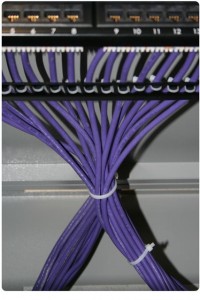 A quick introduction to Cat-5, Cat-5e, Cat-6, Cat-6e…
A quick introduction to Cat-5, Cat-5e, Cat-6, Cat-6e…
Both CAT-5 and CAT-5e have very similar electrical specification, but the differences between CAT-5 and CAT-5e show in all aspects of performance: capacitance, frequency, resistance, and attenuation. The superior electrical performance of CAT-5e means that the cable will support bandwidth hungry applications such as gigabit Ethernet or analog video. This is why CAT-5 is no longer a standard to be installed on to a modern network.
Category 6 cable, commonly referred to as Cat-6, is a cable standard for Gigabit Ethernet and is backward compatible with the Category 5/5e and Category 3 cable standards. Cat-6 features more stringent specifications for crosstalk and system noise. The cable standard provides performance of up to 250 MHz and is suitable for 10BASE-T / 100BASE-TX and 1000BASE-T (Gigabit Ethernet). It is expected to suit the 10GBASE-T (10Gigabit Ethernet) standard, although with some limitations on length if unshielded Cat-6 cable is used. Category 6 and 6e should be considered for any new facilities to ensure the best life from the infrastructure against developments in technology.
A small note on Cat-7 is that if you have a project that you believe may need Cat-7 then please contact us for more detailed advice. This is due to the particular installation challenges Cat-7 presents. With it having a higher specification for the cores and the shielding, it is very inflexible and difficult to handle. Many traditional termination systems cannot handle the thicker shielding and there may be more suitable alternatives for your networking needs and budget.
What is the difference between the types of cable – UTP, Patch, Stranded, Solid…
UTP stands for Unshielded Twisted Pair. It is a cable type with pairs of twisted insulated copper conductors contained in a single sheath.
Stranded cable has several small gauge wires in each separate insulation sleeve. Stranded cable is more flexible, making it more suitable for shorter distances, such as patch cords.
Solid has one larger gauge wire in each sleeve. Solid cable has better electrical performance than stranded cable and is traditionally used for inside walls and through ceilings – any type of longer run of cable.
Patch Cables are made of stranded copper conductors for flexibility. This construction is great for the flexing and the frequent changes that occur at the wall outlet or patch panel. The stranded conductors do not transmit data signals as far as solid cable.
What is the difference between 10BASE-T, 100BASE-T and 1000BASE-T?
10BASE-T is the IEEE standard that defines the requirement for sending information at 10 Mbps on unshielded twisted-pair cabling, and defines various aspects of running Ethernet on this cabling.
100BASE-T is the IEEE standard that defines the requirement for sending information at 100 Mbps on unshielded twisted-pair cabling, and defines various aspects of running baseband Ethernet on this cabling.
1000BASE-T (also called gigabit Ethernet) is the IEEE standard that defines the requirement for sending information at 1000 Mbps on unshielded twisted-pair cabling, and defines various aspects of running baseband Ethernet on this cabling
What is a cross-over cable?
A cross-over cable is a segment of cable that crosses over pins 1&2 and 3&6. This cable is normally used to connect two computers without the use of a hub, or can be used to cascade two hubs without using an uplink port. Some DSL modems require a crossover cable to the PC or hub they are connected to.
What are the maximum lengths for cables?
For Solid UTP: ?Fast Ethernet 100baseT 100 Meters (328 feet) ?Twisted Pair Ethernet 10baseT 100 Meters (328 feet)
Solutions House recommended maximum lengths for Stranded Patch Cables: Fast Ethernet 100baseT 10 Meters (33 feet) ?Twisted Pair Ethernet 10baseT 10 Meters (33 feet)
What are the operating temperatures for cable?
Operating Temp for standard CAT-5e/6/6e cable is between 0C and 60C. However, externally rated cable extends that to between -10C and 70C. It is also important to use externally rates cable for outdoor cable runs due to weathering and EMI. Sun damage in particular can degrade your cable shielding over just one summer. The shielding will go brittle and flake off, rendering you cable useless.
What is EMI and how can you prevent it?
EMI stands for Electro-Magnetic Interference. It is potentially harmful to your communications system because it can lead to signal loss and degrade the overall performance of high-speed, CAT-5e cabling. EMI is interference in signal transmission or reception and is caused by the radiation of electrical or magnetic fields which are present near power cables, heavy machinery, or fluorescent lighting.
Avoiding EMI is as simple as not laying your network cable within 12″ of electrical cable, or if needed switching from UTP to more expensive shielded cable.
I would like some project specific advice?
Either call one of our solutions team on 01928 515 600, or email us some details to contact@solutionshouse.ltd.uk and one of our engineers can give you some tailored advice.


